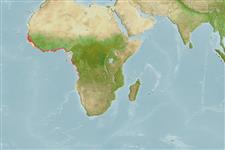Environment: milieu / climate zone / depth range / distribution range
Ecologia
marinhas; Água doce; estuarina; intervalo de profundidade 1 - 50 m (Ref. 26999). Tropical; 21°N - 29°S, 20°W - 15°E
Eastern Atlantic: coastal waters of West Africa from Mauritania to Angola or Namibia (Ref. 4445, 81265, 81629). Sometimes it enters freshwater, like in Cross River and Kouilou-Niari River (Ref. 81629). It is often confused with Elops senegalensis (Ref. 81629).
Tamanho / Peso / Idade
Maturity: Lm ? range ? - ? cm
Max length : 100.0 cm TL macho/indeterminado; (Ref. 5377); common length : 60.0 cm TL macho/indeterminado; (Ref. 2683)
Espinhos dorsais (total): 0; Espinhos anais 0. Diagnosis: Elops lacerta is characterized by 17-19 gill-rakers on lower limb of first gill arch and small scales, those in lateral line numbering 72 to 83 and ornamented with a small, unbranched, tubule (Ref. 2844, 81265, 81629).
Elops lacerta lives in shallow coastal waters over sandy/muddy bottoms, occasionally entering brackish waters and the lower reaches of rivers; from inshore and some way up tidal rivers to edge of shelf (Ref. 4445, 81265, 81629). The reproduction takes place in the sea (Ref. 81265). It feeds primarily on small fishes, mainly clupeids, crustaceans and molluscs; large specimens also feed on insects (Ref. 81629).
Life cycle and mating behavior
Maturidade | Reprodução | Desova | Ovos | Fecundidade | Larvas
Whitehead, P.J.P., 1990. Elopidae. p. 118-119. In J.C. Quero, J.C. Hureau, C. Karrer, A. Post and L. Saldanha (eds.) Check-list of the fishes of the eastern tropical Atlantic (CLOFETA). JNICT, Lisbon; SEI, Paris; and UNESCO, Paris. Vol. 1. (Ref. 4445)
Categoria na Lista Vermelha da IUCN (Ref. 130435)
Ameaça para o homem
Harmless
Utilização humana
Pescarias: espécies comerciais; peixe desportivo: sim
Mais informação
Nomes comunsSinónimosMetabolismoPredadoresEcotoxicologiaReproduçãoMaturidadeDesovaAgregação para desovaFecundidadeOvosDesenvolvimento dos ovos
ReferênciasAquaculturaPerfil para aquaculturaEstirpesGenéticaElectrophoresesHereditariedadeDoençasProcessamentoNutrientsMass conversion
ColaboradoresFotografiasStamps, Coins Misc.SonsCiguateraVelocidadeTipo de nataçãoÁrea branquialOutras referênciasCérebrosVisão
Ferramentas
Relatórios especiais
Descarregue XML
Fontes da internet
Estimates based on models
Preferred temperature (Ref.
123201): 23.8 - 28, mean 26.7 °C (based on 68 cells).
Phylogenetic diversity index (Ref.
82804): PD
50 = 0.5176 [Uniqueness, from 0.5 = low to 2.0 = high].
Bayesian length-weight: a=0.00646 (0.00487 - 0.00855), b=2.97 (2.89 - 3.05), in cm total length, based on LWR estimates for this species (Ref.
93245).
Nível Trófico (Ref.
69278): 4.2 ±0.75 se; based on food items.
Generation time: 1.5 ( na - na) years. Estimated as median ln(3)/K based on 1
growth studies.
Resiliência (Ref.
120179): Médio, tempo mínimo de duplicação da população 1,4 - 4,4 anos (Assuming tm=2-3; K=0.7 for juveniles).
Prior r = 0.57, 95% CL = 0.37 - 0.85, Based on 1 stock assessment.
Fishing Vulnerability (Ref.
59153): Low to moderate vulnerability (32 of 100).
Climate Vulnerability (Ref.
125649): Very high vulnerability (83 of 100).
Nutrients (Ref.
124155): Calcium = 100 [59, 207] mg/100g; Iron = 1.23 [0.71, 2.15] mg/100g; Protein = 17.2 [14.7, 20.3] %; Omega3 = 0.197 [0.105, 0.378] g/100g; Selenium = 63.3 [29.7, 146.8] μg/100g; VitaminA = 8.36 [3.04, 23.05] μg/100g; Zinc = 0.981 [0.695, 1.430] mg/100g (wet weight);
